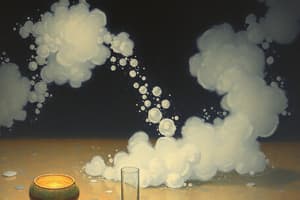Podcast
Questions and Answers
What defines the change in concentration of a reactant or product with time?
What defines the change in concentration of a reactant or product with time?
- extent of reaction
- reaction kinetics
- reaction rate (correct)
- rate law
Which expression describes the relationship between the rate of a reaction, rate constant, and reactant concentrations?
Which expression describes the relationship between the rate of a reaction, rate constant, and reactant concentrations?
- rate coefficient
- reaction quotient
- rate law (correct)
- kinetic equation
In which type of reaction does the stoichiometric coefficient correspond to the order of reaction?
In which type of reaction does the stoichiometric coefficient correspond to the order of reaction?
- elementary reactions (correct)
- unimolecular reaction
- multistep reactions
- pseudo-first order reaction
What does a constant half-life in a series of decomposition events indicate about the reaction's order?
What does a constant half-life in a series of decomposition events indicate about the reaction's order?
If the half-life doubles after each decomposition event, what is the order of the reaction?
If the half-life doubles after each decomposition event, what is the order of the reaction?
What is the minimum energy necessary to initiate a reaction known as?
What is the minimum energy necessary to initiate a reaction known as?
For a reaction to occur, which combination of conditions is necessary beyond mere contact?
For a reaction to occur, which combination of conditions is necessary beyond mere contact?
What term describes a chemical species formed in early steps and consumed later in a reaction?
What term describes a chemical species formed in early steps and consumed later in a reaction?
Which algorithm is primarily used for simulating stochastic processes as outlined by the Chemical Master Equation (CME)?
Which algorithm is primarily used for simulating stochastic processes as outlined by the Chemical Master Equation (CME)?
What type of information does the Chemical Master Equation (CME) require to operate effectively?
What type of information does the Chemical Master Equation (CME) require to operate effectively?
What does the Chemical Langevin Equation (CLE) primarily describe?
What does the Chemical Langevin Equation (CLE) primarily describe?
The CLE serves as an approximation to which of the following equations?
The CLE serves as an approximation to which of the following equations?
What type of random fluctuations does the noise term in the CLE account for?
What type of random fluctuations does the noise term in the CLE account for?
Which numerical method is often utilized to solve the Chemical Langevin Equation?
Which numerical method is often utilized to solve the Chemical Langevin Equation?
The CLE is derived by integrating a noise component into which kind of equations?
The CLE is derived by integrating a noise component into which kind of equations?
In deterministic kinetics, how are reaction rates generally expressed?
In deterministic kinetics, how are reaction rates generally expressed?
What does the Langmuir isotherm constant 'a' represent?
What does the Langmuir isotherm constant 'a' represent?
Which type of catalysis involves one of the products catalyzing the reaction itself?
Which type of catalysis involves one of the products catalyzing the reaction itself?
What is the primary focus of microkinetics?
What is the primary focus of microkinetics?
What phenomenon describes the effect of isotopes on reaction rates?
What phenomenon describes the effect of isotopes on reaction rates?
What relationship does the Arrhenius equation describe?
What relationship does the Arrhenius equation describe?
What occurs at the transition state of a chemical reaction?
What occurs at the transition state of a chemical reaction?
In a pseudo-first-order reaction, which statement is correct?
In a pseudo-first-order reaction, which statement is correct?
What happens to x/m in a Langmuir isotherm when pressure P is very low?
What happens to x/m in a Langmuir isotherm when pressure P is very low?
Flashcards
Reaction Rate
Reaction Rate
The change in concentration of a reactant or product per unit time.
Rate Law
Rate Law
The relationship between the reaction rate and the concentrations of reactants.
Elementary Reactions
Elementary Reactions
Reactions where the reaction order is directly related to the stoichiometric coefficient.
Zero-Order Reaction
Zero-Order Reaction
Signup and view all the flashcards
First-Order Reaction
First-Order Reaction
Signup and view all the flashcards
Second-Order Reaction
Second-Order Reaction
Signup and view all the flashcards
Activation Energy
Activation Energy
Signup and view all the flashcards
Reaction Intermediate
Reaction Intermediate
Signup and view all the flashcards
Steady-State Approximation
Steady-State Approximation
Signup and view all the flashcards
Langmuir isotherm constant (a)
Langmuir isotherm constant (a)
Signup and view all the flashcards
Autocatalysis
Autocatalysis
Signup and view all the flashcards
Microkinetics
Microkinetics
Signup and view all the flashcards
Kinetic Isotope Effect
Kinetic Isotope Effect
Signup and view all the flashcards
Arrhenius equation
Arrhenius equation
Signup and view all the flashcards
Transition state
Transition state
Signup and view all the flashcards
Pseudo-First-Order Reaction
Pseudo-First-Order Reaction
Signup and view all the flashcards
x/m at low pressure (Langmuir isotherm)
x/m at low pressure (Langmuir isotherm)
Signup and view all the flashcards
CME solver
CME solver
Signup and view all the flashcards
CME requirements
CME requirements
Signup and view all the flashcards
CLE description
CLE description
Signup and view all the flashcards
CLE approximation
CLE approximation
Signup and view all the flashcards
CLE noise source
CLE noise source
Signup and view all the flashcards
CLE solver
CLE solver
Signup and view all the flashcards
CLE derivation
CLE derivation
Signup and view all the flashcards
Deterministic Kinetics
Deterministic Kinetics
Signup and view all the flashcards
Deterministic rate description
Deterministic rate description
Signup and view all the flashcards
Study Notes
Surface Chemistry
- Surface chemistry is the study of reactions at interfaces.
- It's not just about reactions in bulk solutions, gases, or all phases.
Types of Adsorption
- Physical Adsorption: Adsorbate molecules held on the surface by van der Waals forces.
- Chemical Adsorption: Adsorbate molecules held by strong chemical bonds.
- Internal Adsorption: Adsorption within the pores of the material.
- Electrostatic Adsorption: Adsorption due to electrostatic forces.
Factors Affecting Adsorption
- Temperature: Higher temp generally decreases adsorption.
- Nature of adsorbent: Different materials adsorb different substances to varying degrees.
- Particle size of adsorbent: Smaller particles generally have higher surface area and thus greater adsorption.
Catalyst for Hydrogenation of Oils
- Nickel is commonly used as a catalyst in the hydrogenation of oils.
Chemisorption
- Chemisorption involves strong chemical bonds.
- Chemisorption is not reversible.
- Chemisorption is temperature dependent.
Langmuir Adsorption Isotherm
- Langmuir adsorption assumes adsorption at specific homogeneous sites, one molecule per site.
- Adsorption occurs in a single layer.
- Interactions between adsorbed molecules are negligible.
Studying Surface Area
- BET method is one method used to study the surface area.
- X-ray diffraction is used to study the crystal structure and bonding, which can help understand properties related to surface areas
- Mercury porosimetry is used, among other methods, to study porosity related to surface area.
- Gas adsorption is used in surface area studies
Stoichiometric Matrix (Example)
- The provided question refers to finding the correct stoichiometric matrix for a chemical reaction relating to the rate of the reaction, relating to each reaction
Reaction Rate
- Reaction rate is the change in concentration of a reactant or product with time.
- The rate law expresses the relationship of the reaction rate constant, and reactant concentrations.
- Different reaction orders relate to the underlying rate laws
Reaction Order
- The order of a reaction isn't always directly related to the stoichiometric coefficients.
- Elementary reactions follow this relationship(Reaction order is equivalent to stoichiometric coefficients).
- Other reaction types may deviate from this direct relationship
Activation Energy
- The minimum amount of energy required to initiate a reaction is activation energy.
Decomposition Reaction Orders
- If the half-life of a chemical reaction doubles each time, the reaction is a first-order reaction
- If the half-life stays the same regardless of the decomposition events, the reaction is a zero-order reaction
Proper Reactions
- For a reaction to occur, the reactants must have sufficient energy and proper orientation.
Reaction Intermediates
- Reaction intermediates are created during early steps of the reaction but consumed in later steps, useful for chemical reaction elucidation; they are temporary entities
Equilibrium Approximation
- Steady state approximation is used in rates of reactions when some conditions are equal to zero
Transport Processes
- Transport processes encompass the movement of substances or properties.
- Diffusion is one transport process and involves the movement of a substance from an area of higher concentration to an area of lower concentration.
- Conduction is a transport process, involving the movement of heat
Diffusion
- Diffusion is a common transport process that follows Fick's Law, which helps explain diffusion.
Studying That Suits You
Use AI to generate personalized quizzes and flashcards to suit your learning preferences.




